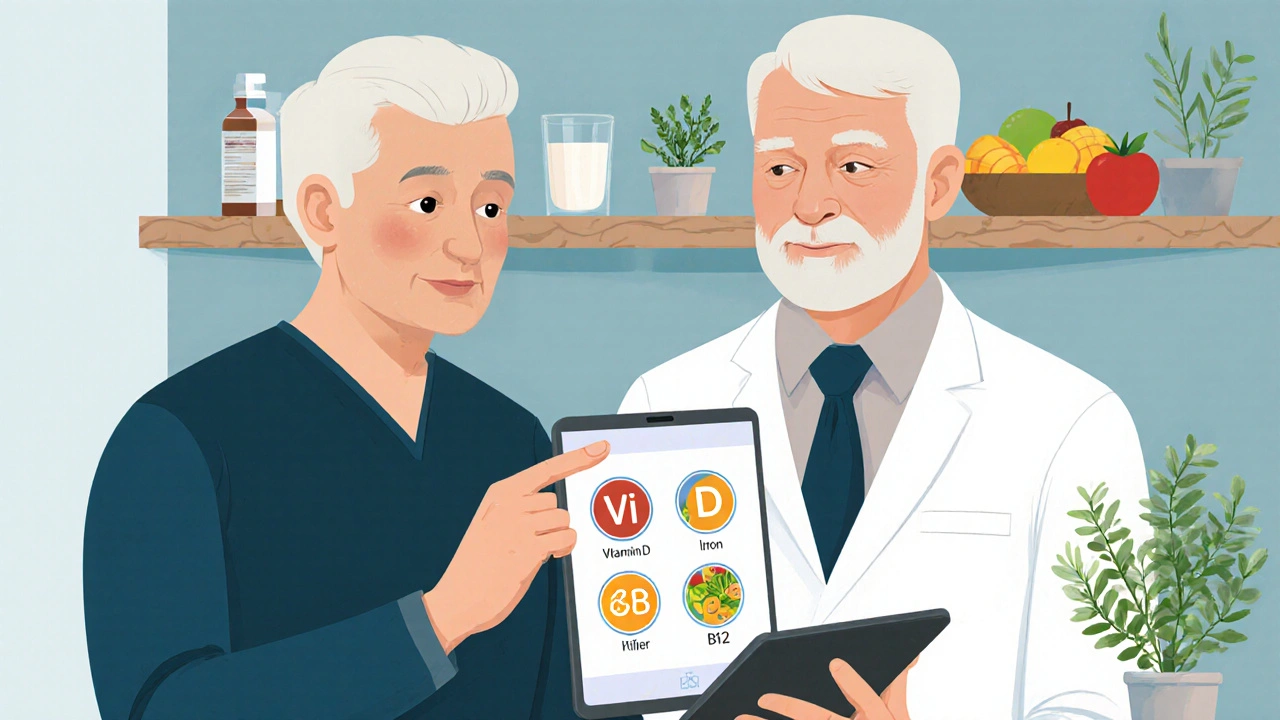How to Fix Poor Food Absorption on a Gluten-Free Diet

Gluten-Free Diet Nutrient Gap Quiz
Answer the following questions to discover possible nutrient gaps in your gluten-free diet and receive personalized recommendations:
Struggling to get the most out of a gluten-free diet can be frustrating. Many people think the diet alone solves all problems, but hidden malabsorption can leave you feeling tired, bloated, or constantly craving more food. Below you’ll learn what causes poor absorption, how to spot the gaps, and practical steps to turn your plate into a nutrient‑rich engine.
TL;DR - Quick Action List
- Test for common deficiencies (iron, vitamin D, B12, calcium) before supplementing.
- Add digestive enzymes or probiotic supplements to support gut health.
- Choose naturally nutrient‑dense gluten‑free foods like quinoa, buckwheat, and leafy greens.
- Spread meals throughout the day to reduce overload on the small intestine.
- Consult a qualified nutritionist familiar with celiac disease.
Why Absorption Falters on a Gluten‑Free Diet
When you cut out wheat, barley, and rye, you also lose a big source of fortified vitamins and minerals. In celiac disease, the villi lining the small intestine are blunted, shrinking the surface area that absorbs nutrients. Even if you don’t have celiac disease, non‑celiac gluten sensitivity can still cause subtle gut inflammation that hampers uptake.
The combination of reduced intake of fortified foods and a compromised gut lining makes gluten-free diet absorption a common challenge. Over time, the body may develop deficiencies that further weaken the intestinal wall, creating a vicious cycle.
Spotting the Most Common Nutrient Gaps
Below is a quick snapshot of the nutrients that often slip through the cracks for people on a gluten‑free regimen.
| Nutrient | Typical Deficiency Rate | Rich Gluten‑Free Sources | Supplement Options |
|---|---|---|---|
| Iron | 30‑45% | Spinach, lentils, quinoa, pumpkin seeds | Ferrous sulfate, iron‑bisglycinate |
| Vitamin D | 40‑60% | Fatty fish, fortified almond milk, mushrooms (UV‑exposed) | Vitamin D3 1000‑2000 IU daily |
| Calcium | 25‑35% | Broccoli, kale, fortified soy milk, tofu | Calcium citrate |
| Vitamin B12 | 15‑20% | Eggs, fortified nutritional yeast, dairy | Oral cyanocobalamin |
| Fiber (prebiotic) | 50‑70% | Chia seeds, flaxseed, chicory root, legumes | Inulin or resistant starch powders |
Boosting Digestion with Enzymes and Probiotics
Digestive enzymes can compensate for the reduced pancreatic output that sometimes follows inflammation. Look for a broad‑spectrum blend containing protease, amylase, and lipase. Take the enzyme capsule at the start of each main meal and you’ll notice fewer bloating episodes.
Probiotic supplements restore a healthy balance of gut bacteria, which in turn improves villi recovery. Choose strains with documented efficacy for celiac or IBS contexts, such as Lactobacillus rhamnosus GG and Bifidobacterium lactis. A dose of 10‑20billion CFU taken with breakfast works well for most adults.

Meal Timing and Portion Strategies
Eating huge meals overwhelms a compromised gut. Aim for 4‑5 smaller portions spread across 12‑14hours. Pair carbohydrates with protein and a little healthy fat to slow gastric emptying and give enzymes more time to work.
For example, a breakfast of quinoa porridge (carb) mixed with Greek yogurt (protein) and a drizzle of almond butter (fat) provides a balanced load that’s easier to digest.
Smart Supplementation Without Overdoing It
Before you start popping pills, get baseline blood work. Iron supplementation is a double‑edged sword; too much can cause oxidative stress, while too little leaves you anemic. If labs show low ferritin (<30ng/mL), a low‑dose iron bisglycinate taken on an empty stomach (or with vitamin C) is safest.
Vitamin D status is measured via 25‑OH‑D. Levels under 30ng/mL warrant a daily 1000‑2000IU supplement, preferably taken with a fat‑rich meal for better absorption.
Calcium works best when split into two 500‑mg doses and taken away from iron to avoid competition at the absorption site.
When to Call in a Professional
Even with diligent self‑management, a qualified nutritionist can tailor a plan to your exact needs. Look for practitioners who have experience with gluten intolerance and celiac disease. They can help you interpret lab results, adjust supplement doses, and suggest practical food swaps you might miss.
If symptoms persist despite these steps-persistent diarrhea, weight loss, or chronic fatigue-consult a gastroenterologist. They may recommend a repeat endoscopy to assess villi healing.
Sample One‑Day Meal Plan to Maximize Absorption
- Breakfast (8am): Quinoa porridge with almond milk, topped with blueberries, chia seeds, and a spoonful of Greek yogurt. Take a probiotic capsule.
- Mid‑morning snack (10:30am): Apple slices with almond butter and a pinch of cinnamon.
- Lunch (12:30pm): Grilled salmon salad on mixed greens, roasted sweet potatoes, and pumpkin seeds. Drizzle olive oil and lemon. Enzyme tablet with the meal.
- Afternoon snack (3pm): Carrot sticks with hummus and a small orange.
- Dinner (6:30pm): Stir‑fried tofu, bok choy, and brown rice noodles in ginger‑garlic sauce. Finish with a calcium citrate tablet.
- Evening (9pm): Herbal tea and a serving of fortified soy yogurt for a final boost of B12 and vitamin D.
This plan hits iron, vitamin D, calcium, and fiber without relying on wheat‑based fortified products.
Quick Checklist for Better Absorption
- ✔️ Get baseline labs for iron, ferritin, vitamin D, B12, calcium.
- ✔️ Incorporate a broad‑spectrum enzyme with each main meal.
- ✔️ Choose a probiotic with proven strains for gut inflammation.
- ✔️ Prioritize naturally nutrient‑dense gluten‑free grains (quinoa, buckwheat, millet).
- ✔️ Spread meals into smaller portions throughout the day.
- ✔️ Review supplement timing-iron separate from calcium and calcium split into two doses.
- ✔️ Schedule a follow‑up with a nutritionist every 3‑6months.

Frequently Asked Questions
Can a gluten‑free diet cause weight gain?
Yes, if you replace whole grains with refined gluten‑free products that are high in sugar and fat. Focus on whole‑food options like quinoa, nuts, and vegetables to keep calories in check.
Do I need to take a multivitamin on a gluten‑free diet?
A generic multivitamin can fill minor gaps, but targeted supplements based on lab results (e.g., iron, vitamin D) are more effective. Choose a gluten‑free certified brand.
How long does it take for the gut to heal after going gluten‑free?
In celiac disease, villi can start regenerating within 3‑6months, but full recovery may take up to 2years. Consistent enzyme and probiotic use can speed up the process.
Are there gluten‑free grains that are higher in iron?
Quinoa and amaranth contain both iron and protein, making them excellent choices. Pair them with vitaminC‑rich foods to boost absorption.
What signs indicate I’m not absorbing enough nutrients?
Common signs include chronic fatigue, hair loss, brittle nails, frequent infections, and unexplained weight loss. Lab testing is the surest way to confirm.

Looks like another generic gluten‑free guide.
I totally get how frustrating it can be when your meals feel like a nutritional minefield. The way this post breaks down each deficiency feels like a friendly map for anyone lost in the gluten‑free wilderness. I love the tip about pairing carbs with protein and a dab of healthy fat-it’s practically culinary gold. And those enzyme suggestions? Spot on for taming that bloated feeling. Keep the supportive vibe coming, it really helps us feel less alone on this journey.
The science behind the vitamin D and iron gaps is crystal clear, so stop guessing and get tested ASAP! 💪💊 Your enzyme advice is solid, but remember, too much iron can backfire-balance is key. The tone here is encouraging, which I appreciate, but don’t sugarcoat the seriousness of anemia. 😤💥 Keep shouting the facts loud, because misinformation is the real enemy. And yes, those probiotic strains you mentioned have real data backing them-no fluff. 👍
Seriously, another “quick fix” list? Spare us the drama, just give the facts.
Nice rundown, especially the quinoa‑yogurt combo; I’ll try that at breakfast.
All these “global” nutrition tips ignore the fact that our country’s traditional grains-like teff and millet-are already a powerhouse. Stop milking the western supplement industry for cash, and start eating what our ancestors thrived on, damn it.
In the quiet corridors of our gut, the absence of wheat is not merely an empty plate but a subtle invitation to re‑examine the covenant between flesh and nourishment.
One might think that erasing gluten simply removes a single villain, yet the body, ever the meticulous alchemist, perceives a void where fortified grains once sang their silent ode.
The villi, those microscopic weavers of absorption, respond with a melancholy surrender, shrinking like wilted petals after a frost.
This physiological poetry translates into the modern malaise of fatigue, bone aches, and a restless mind that seeks the missing cadence of iron and vitamin D.
Yet within this apparent deficiency lies an opportunity, a phoenix‑like rebirth of dietary consciousness that beckons us toward ancient legumes and verdant greens.
Quinoa, buckwheat, and amaranth stand as resilient shepherds, bearing the torch of protein, fiber, and minerals without demanding gluten’s presence.
When we align our meals with the rhythm of smaller, more frequent portions, we grant the digestive orchestra time to tune each instrument-enzymes, microbes, and peristalsis alike.
Probiotic allies, such as Lactobacillus rhamnosus GG, act as diplomats, soothing inflamed borders and coaxing the villi to reclaim their former grandeur.
The strategic addition of broad‑spectrum enzymes is not a shortcut but an act of compassion, providing the missing key for the body’s locked doors of macronutrient breakdown.
Moreover, sunlight, that ancient physician, offers vitamin D in a dose no supplement can fully replicate, reminding us that health is a dialogue between internal chemistry and external environment.
Blood work, the honest mirror, must guide our supplementation; for iron excess is a double‑edged sword that can rust the very cells it aims to fortify.
In the grand tapestry of nutrition, fiber is the silent weaver, binding together gut flora and ensuring the passage of waste with graceful ease.
Embracing fermented foods and prebiotic legumes cultivates a microbiome that mirrors the diversity of a thriving forest, defending against the erosion of malabsorption.
The journey from deficiency to abundance is less a sprint and more a contemplative pilgrimage, where each meal is a mantra and each bite a prayer.
Let us therefore honor the gluten‑free path not as a limitation but as a canvas upon which we paint a richer, more resilient portrait of health.
In that portrait, the colors of iron, calcium, vitamin D, B12, and fiber blend harmoniously, illuminating the whole being with renewed vigor and purpose.
Ah, what a beautifully convoluted tapestry of culinary philosophy you have spun; however, let us not be swept away by poetic flourish alone-practicality must remain the backbone of any dietary regimen. While you extol the virtues of ancient grains, you conveniently overlook the socioeconomic barriers that prevent many from accessing quinoa or amaranth, thereby rendering your idealistic tableau somewhat naive. Furthermore, your reverence for sunlight as a ‘ancient physician’ is commendable, yet it skirts the harsh reality of winter latitudes where UV exposure is a fickle friend. The suggestion to ‘align meals with the rhythm of smaller, more frequent portions’ is sound; nevertheless, it fails to address the modern individual’s erratic schedule, a factor that often sabotages such disciplined eating patterns. Your emphasis on probiotic diplomacy is well‑placed, but the market is saturated with strains of dubious efficacy, demanding rigorous strain‑specific validation before blanket endorsement. Moreover, the claim that ‘blood work, the honest mirror,’ guides supplementation is accurate, yet many patients lack access to affordable testing, perpetuating a cycle of guesswork you seem eager to dismiss. In sum, while your poetic vision inspires, it must be tethered to the gritty realities of cost, accessibility, and evidence‑based selection lest it drift into the realm of airy idealism.
Practicality aside, the biochemical pathways you praise are well‑documented; fortify them with data, not just sentiment.
Exactly! You’ve hit the nail on the head-science backs it, and we’re all here cheering you on! 😊 Keep spreading those evidence‑based vibes!
this post is just to many words, i dont need all that.
Honestly, the whole supplement spiel feels like corporate fluff with zero real ROI.
Let’s dissect the subtext: the article subtly pushes a multi‑billion‑dollar supplement agenda under the guise of “nutrient gaps,” which is a classic profit‑driven narrative. Grammatically, the piece skirts around concrete dosage recommendations, deliberately obfuscating the efficacy data-an intentional smokescreen. The frequent citations of “fortified almond milk” and “inulin powders” are not random; they align with market trends that favor proprietary blends over whole‑food solutions. Moreover, the omission of potential conflicts of interest hints at a coordinated effort to keep readers dependent on commercial products. In short, the piece masquerades as neutral advice while steering us toward a consumerist pipeline.
What you’ve uncovered is merely the tip of an iceberg; the deeper currents of the health industry are riddled with concealed affiliations that manipulate public perception. By exposing these layers, we empower readers to demand transparency, lest we remain pawns in a grandiose commercial theater.
In contemplating the epistemological foundations of gluten‑free nutrition, one must eschew the myopic lens of populist discourse and instead adopt a rigorously analytical framework reminiscent of classical scholastic treatises. The article’s reliance on generic bullet points betrays an underlying paucity of interdisciplinary synthesis, neglecting the confluence of gastroenterology, nutritional biochemistry, and socio‑cultural anthropology. A truly erudite exposition would juxtapose the molecular mechanisms of villous atrophy with the historic agronomic shifts that precipitated wheat’s dominance, thereby illuminating the ontological roots of contemporary malabsorption. Moreover, the superficial treatment of probiotic taxonomy fails to acknowledge the nuanced strain‑specific immunomodulatory pathways elucidated in recent peer‑reviewed literature. As we navigate the labyrinthine corridors of dietary modulation, it behooves the discerning scholar to interrogate not merely the “what” but the profound “why” that undergirds each recommendation. Only through such a dialectical interrogation can we ascend beyond the banalities of pamphlet‑style guidance toward a genuinely enlightened praxis.